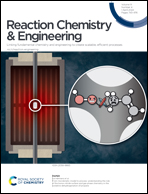Encapsulation of TixFeyLamOz nanoparticles into NH2-MIL-125(Ti) to fabricate a promising photocatalyst for the C–N coupling reaction†
Abstract
An array of organic compounds and natural products can be synthesized through carbon–nitrogen coupling reactions. Photocatalysts are used with different structures, considering their advantages such as purity, low cost, and use of sunlight as an energy source. Metal–organic frameworks (MOFs), with their high surface activity, facile electron migrations, and stability, are highlighted. In this study, we synthesized a new composite by encapsulating TixFeyLamOz nanoparticles at different concentrations into NH2-MIL125(Ti). Several types of analyses were used to characterize the obtained composites and measure their optical properties, including X-ray diffraction, high-resolution transmission electron microscopy, energy-dispersive X-ray spectroscopy, field emission scanning electron microscopy, Fourier transform infrared spectroscopy, diffuse reflectance UV/vis spectra, photoluminescence, nuclear magnetic resonance spectroscopy, mass spectrometry, Brunauer–Emmett–Teller surface area measurement, cyclic voltammetry, inductively coupled plasma, and photocurrent spectroscopy. The obtained composite was used as a photocatalyst for the carbon–nitrogen coupling reactions of aniline and ten different derivatives. La(1.05)@MOF (second lowest concentration) showed the highest photocatalytic activity under visible light to power the C–N coupling reaction. In addition, we performed an in-depth study on the mechanism of these composites and the pathway of electron migration, which have rarely been reported. We found that the optimum loading concentration can assist in increasing the optical and physical properties of photocatalysts, which consequently leads to significant improvement in the C–N coupling reactions to obtain an 80% yield.



 Please wait while we load your content...
Please wait while we load your content...